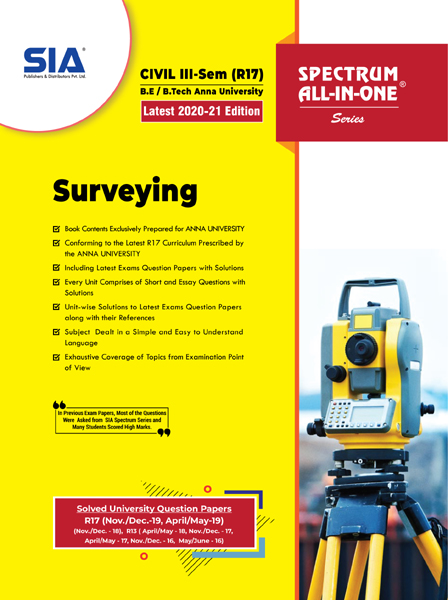

Note: Please check your Spam or Junk folder, in case you didn't receive the email with verification code.
SYLLABUS
Unit-1:
Fundamentals of Conventional Surveying and Levelling Classifications and basic principles of surveying - Equipment and accessories for ranging and chaining - Methods of ranging - Compass - Types of Compass - Basic Principles- Bearing – Types - True Bearing - Magnetic Bearing - Levelling- Principles and theory of Levelling – Datum- - Bench Marks – Temporary and Permanent Adjustments- Methods of Levelling- Booking – Reduction - Sources of errors in Levelling - Curvature and refraction.
Unit-2:
Theodolite and Tacheometric Surveying Horizontal and vertical angle measurements - Temporary and permanent adjustments - Heights and distances - Tacheometer - Stadia Constants - Analytic Lens -Tangential and Stadia Tacheometry surveying - Contour – Contouring – Characteristics of contours – Methods of contouring – Tacheometric contouring - Contour gradient – Uses of contour plan and map.
Unit-3:
Control Surveying and Adjustment Horizontal and vertical control – Methods – specifications – triangulation- baseline – satellite stations – reduction to centre- trigonometrical levelling – single and reciprocal observations – traversing – Gale’s table. - Errors Sources- precautions and corrections – classification of errors - true and most probable values - weighed observations – method of equal shifts – principle of least squares - normal equation – correlates- level netsadjustment of simple triangulation networks.
Unit-4:
Advanced Topics in Surveying Hydrographic Surveying – Tides – MSL – Sounding methods – Three point problem – Strength of fix – astronomical Surveying – Field observations and determination of Azimuth by altitude and hour angle methods –.Astronomical terms and definitions - Motion of sun and stars - Celestial coordinate systems - different time systems - Nautical Almanac - Apparent altitude and corrections - Field observations and determination of time, longitude, latitude and azimuth by altitude and hour angle method.
Unit-5:
Modern Surveying Total Station : Advantages - Fundamental quantities measured - Parts and accessories - working principle - On board calculations - Field procedure - Errors and Good practices in using Total Station GPS Surveying : Different segments - space, control and user segments - satellite configuration - signal structure - Orbit determination and representation - Anti Spoofing and Selective Availability - Task of control segment - Hand Held and Geodetic receivers - data processing - Traversing and triangulation.
 No Preview is available for this book
No Preview is available for this book

 Get 100 instant uPoints on the purchase of Rs.100 or above for each order.
Get 100 instant uPoints on the purchase of Rs.100 or above for each order.
CategoriesEngineering

Format EPUB

TypeeBook